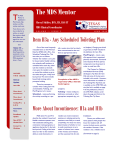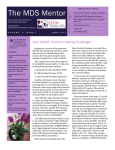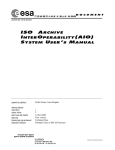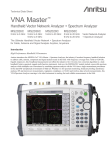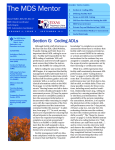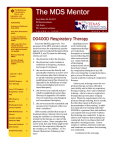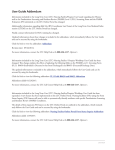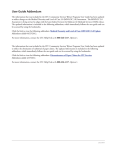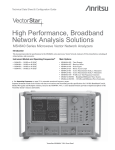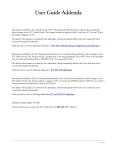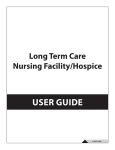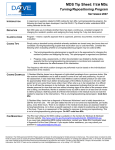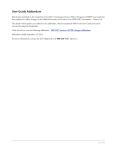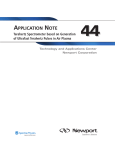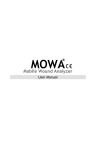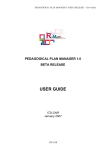Download The MDS Mentor September 2008 - Texas Department of Aging and
Transcript
STATE OF TEXAS T he MDS Mentor is published in March, June, September, and December each year. If you have an article, an idea for an article, or would like to give us feedback, please see page 4 for our contact information. The MDS Mentor Cheryl Shiffer, BSN, RN, RAC-CT MDS Clinical Coordinator V O L U M E 1 , I S S U E 3 S E P T E M B E R 2 0 0 8 Section M1 - Ulcers Many facility staff have called to tell me that trying to figure out how to code ulcers in Section M1 on the Minimum Data Set (MDS) gives them ulcers of an entirely different variety. Therefore, in an effort to improve resident assessments and employee health, let’s review how to appropriately code Section M1. INSIDE THIS ISSUE: Section M1 1 Section M1 2 Section M2 2 Section M3 2 Automation News 3 Coming Soon 4 Contact Us Websites 5 First, the Resident Assessment Instrument (RAI) User’s Manual, v 2.0, Dec 2002, page 3-159, states that the intent of Section M1 is to “record the number of skin ulcers, at each ulcer stage, on any part of the body.” This includes the feet. Although Section M6 specifically addresses foot problems, the feet are still part of the body and ulcers on the feet are included in M1. Second, although the MDS form requires coding ulcers “due to any cause,” the RAI Manual indicates that “skin ulcers that develop because of circulatory problems or pressure are coded in item M1.” The RAI Manual, and not the form, dictates how the MDS is filled out. So included in Section M1 are pressure ulcers and circulatory ulcers, such as arte- As we move into the beauty of fall, let’s remember the beauty of accurate MDS coding. rial/ischemic ulcers and venous/stasis ulcers. The RAI Manual further clarifies that “Rashes without open areas, burns, desensitized skin, ulcers related to diseases such as syphilis and cancer, and surgical wounds are NOT coded here, but are included in Item M4. Skin tears/shears are coded in Item M4 unless pressure was a contributing factor.” So when pressure was a factor or the tear/shear develops into a pressure ulcer, it must be coded in M1. Section M1 - Staging & Counting Ulcers Now that the types of ulcers that are included in Section M1 are defined, let’s address staging the ulcers. The look-back period for Section M1 is 7 days and the RAI Manual, still on page 3-159, defines the 4 Stages that must be used to stage all ulcers (pressure, arterial and stasis) and notes, “For the MDS assessment, staging of ulcers should be coded in terms of what is seen (i.e., visible tissue) during the look back period. For example, a healing Stage 3 pressure ulcer that has the appearance (i.e., presence of granulation tissue, size, depth, and color) of a Stage 2 pressure ulcer must be coded as a “2” for purposes of the MDS assessment. Facilities certainly may adopt the National Pressure Ulcer Advisory Panel (NPUAP) standards in their clinical practice. However, the NPUAP standards cannot be used for coding on the MDS.” (Continued on page 2) VOLUME 1, ISSUE 3 PAGE Section M1 - Staging & Counting Ulcers (Continued from page 1) If necrotic eschar is present which prohibits accurate staging of the ulcer, then code the skin ulcer as a Stage “4” until the eschar has been debrided to allow staging. According to the RAI Manual, page 3-160, “Debridement of an ulcer merely removes necrotic and decayed tissue to promote healing. The skin ulcer still exists and may or may not be at the same stage as it was prior to debridement. Good clinical practice dictates that the ulcer be re-examined and re-staged after debridement. Do not code the debrided skin ulcer as a surgical wound.” However, the RAI Manual continues with different instructions, “If a skin ulcer is repaired with a flap graft, it should be coded as a surgical wound and not as a skin ulcer. If the graft fails, continue to code it as a surgical wound until healed.” To fill in Section M1, items a. Stage 1, b. Stage 2, c. Stage 3 and d. Stage 4 on the MDS, simply count the number of ulcers corresponding to each stage on the resident’s body and then fill in the number on the form in the appropriate block. If there are no skin ulcers for a particular stage, then record a “0” (zero) in the appropriate box. The limitation is if there are more than 9 skin ulcers at any one stage, enter a “9” (nine) in the appropriate box. The system is not designed to accept a number greater than 9 for ulcers at any one stage. MEOW! Source: RAI User’s Manual, pages 3-159 & 3-160. By C & C They say a cat may lead nine lives, Section M2 - Type of Ulcer Sometimes, facility staff report that they are not sure of the cause or the type of an ulcer. It is important that facility staff involve the resident’s physician and other health team professionals to determine the cause, type and staging of all ulcers to ensure accurate MDS coding. The RAI Manual instructions for Section M2, page 3.161, state the intent is to “code the highest stage for two types of skin ulcers, pressure and stasis, present in the last 7 days.” Some examples of staging pressure and stasis ulcers follow: • Item M2a. Pressure Ulcer - if the highest stage of a pressure ulcer in the last 7 days was a Stage “4”, then code item M2a as a “4”. • Item M2b. Stasis Ulcer - if the highest stage of a stasis ulcer in the last 7 days was a Stage “2”, then code item M2b as a “2”. But a MDS coordinator needs even more to survive. With so many assessments to complete, Who’s got time for trick or treat? Remember these are not the only types of ulcers included in M1. You could have various stages of ulcers coded in M1, but if they are all arterial/ischemic ulcers, M2a and M2b would both be “0” (zero.) Section M3 - History of Resolved/Cured Ulcers Section M3 has one of the longest look-back periods on the MDS, 90 days. The intent is to code if the resident has a history of skin ulcers that have healed, resolved or been cured in the last 90 days. Remember that the reference to skin ulcers contained in Section M3 uses the same definitions of skin ulcers used in Section M1, so it includes pressure, arterial and venous ulcers. If the resident has no history of resolved skin ulcers, Code “0” (zero) for No. If the resident has a history of resolved skin ulcers, Code “1” (one) for Yes. One common question is, “How does an ulcer’s coding change as the result of a surgical flap graft?”. The RAI Manual instructs you to change from coding it as an ulcer in M1 to coding it as a surgical wound in M4g. When this happens, although the ulcer did We are not limited by our old not heal or resolve, the RAI Manual also age; we are liberated by it. instructs you to code M3 as a “1” for Yes. X Stu Mittleman 2 VOLUME 1, ISSUE 3 PAGE Automation News by Cecile Hay, MDS Automation Coordinator Following the path to excellence in completing the MDS. RAI MANUAL UPDATE-JULY 2008 The Centers for Medicare and Medicaid Services (CMS) posted a July 2008 revision to the Long Term Care Facility Resident Assessment Instrument User’s Manual, Version 2.0, 2008. Key changes include: 1. Clarification for completing a significant change assessment when hospice is elected. 2. Outlines factors affecting SNF assessment schedules, coding and late assessments. 3. Gives guidance on when to select Total Dependence vs. Activity Did Not Occur for coding Eating in G1hA. 4. Adds definition of back-dating and clarifies which date to use when signing R2b. 5. Revises guidance for when the flu season begins based on the vaccine being available to the public. 6. Clarifies information concerning HIPPS codes. It is the responsibility of the individuals who complete the MDS to have the most current RAI manual instructions in order to accurately complete the required assessments. The revision table and replacement pages are available at CMS MDS Manuals and Forms. TILES to RUGS (T2R) Effective September 1, 2008, Texas implemented a new Medicaid reimbursement methodology. The federal Resource Utilization Group (RUG), determined by completion of the Minimum Data Set (MDS), replaced the Texas Index for Level of Effort (TILE). A new form, the Long Term-Care Medicaid Information (LTCMI) form replaced MDS Section S and CARE form 3652A. After a MDS assessment is submitted to the state database for a Medicaid nursing home resident with one of the following reasons for assessment: AA8a = 01, 02, 03, 04, 05, or 10, the MDS coordinator submits a LTCMI form to the TMHP Online Portal. Review the TILES to RUGS web site for more on the LTCMI form, information letters (ILs), rules and training. The autumn sun sets quickly into night, I hope I’ve got my assessments right. TILES is gone and RUGS are here to stay, I’m glad the helpdesk is only a phone call away! It is highly recommended that you configure your MDS software to calculate the Medicaid RUG score. This will eliminate Warning Messages –306 and –307, unless the software incorrectly calculates the RUG. Review Texas Medicaid CMI Set & Raven Instructions, IL 08-41 and IL 08-54, on the T2R website for instruction on setting up your software. Call Cecile by phone at 512-438-2396 if you need help. The News in Review Section S Discontinued – Effective September 1, 2008, facilities no longer need to complete MDS Section S. Assessments submitted after September 1, 2008, that have Section S completed, will be accepted without generating a warning message. Your software vendor can help you eliminate Section S. Section U – Facilities are not required to complete Section U, the Medication portion of the MDS. The data is not stored in the state database, but facility management may require completion of Section U for facility purposes. RUG Training Offered – Nurses who complete the LTCMI form are required to take the computer based RUG Training prior to submitting the LTCMI form. NPI Number – The facility’s National Provider Identifier (NPI) number must be entered into MDS item W1. The NPI number Is used to pull assessments into the TMHP portal. If you modify an assessment to add the Extending our hands in care missing NPI number, then it will appear in the and assessment. TMHP portal. 3 Coming Soon You asked and we answered. We are going to put frequently asked questions in writing so everyone can see the answers. We are calling it “MDS Questions Asked and Answered.” Check the following websites for “MDS Questions Asked and Answered:” Texas Minimum Data Set Quality Monitoring Program Resources Send your questions to us at: Cheryl Shiffer, BSN, RN, RAC-CT Cecile Hay, LMSW MDS Questions Asked & Answered Sample Q: I transmitted a batch of assessments and they were all rejected as duplicate records. It was the first time I sent them. A: Duplicate records (error message –80) means the records were previously transmitted. It can happen when you double click on the batch name, causing the software to send the batch twice. Check the validation report menu and look for a report sent the same day, but a couple of minutes earlier than the one you are reviewing. Cheryl Shiffer, BSN, RN, RAC-CT Cecile Hay, LMSW MDS Clinical Coordinator MDS Automation Coordinator 11307 Roszell Street, Room 1910 P.O. Box 149030 San Antonio, TX 78217 Austin, TX 78714-9030 Mail Code: 279-4 Mail Code E-345 Phone: 210.619.8010 Phone: 512.438.2396 Fax: 210.619.8159 (Shared Fax-Call First) Fax: 512.438.4286 (Shared Fax-Call First) E-Mail: [email protected] E-Mail: [email protected] Useful Web Links Centers for Medicare & Medicaid Services (CMS) MDS Web Site: MDS 2.0 Highlights, MDS/ RAI Manual with updates and a link to MDS 3.0. http://www.cms.hhs.gov/NursingHomeQualityInits/20_NHQIMDS20.asp CMS MDS Training Web Site: MDS computer-based training (CBT). http://www.mdstraining.org/upfront/u1.asp Quality Matters MDS Web Site: News and clinical assistance for MDS coordinators. http://mqa.dads.state.tx.us/MDSweb/ DADS MDS Web Site: Texas MDS Policy page. http://www.dads.state.tx.us/providers/MDS/index.cfm Help is Just a Click Away QIES TECHNICAL SUPPORT OFFICE (QTSO): MDS 2.0/3.0, RAVEN and AT&T Client Software information. Validation Report Messages, Guides, Training and DAVE/DAVE 2 Tip sheets. https://www.qtso.com/ Quality Reporting System (QRS): DADS information site on Texas nursing homes. http://facilityquality.dads.state.tx.us/ Nursing Home Compare: CMS site that compares nursing homes in a given area. http://www.medicare.gov/NHCompare/Include/DataSection/Questions/SearchCriteria.asp The MDS Mentor: http://qmweb.dads.state.tx.us/mdsweb/ Sign up for E-mail Updates: Go to http://www.dads.state.tx.us/






